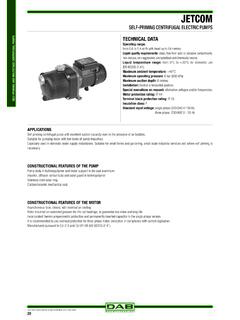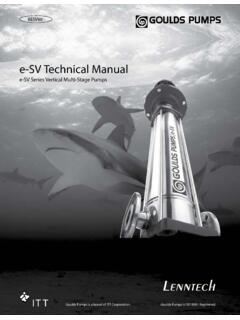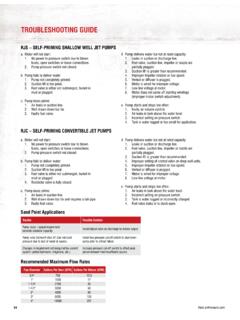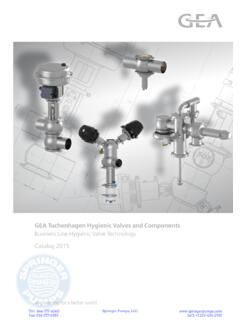Transcription of PUMP DESIGN - Arrakis
1 Arrakis 1 PUMP DESIGN PUMP DESIGN de Jongh & Rijs, editors Latest update: March 2004 Arrakis 2 PUMP DESIGN CONTENTS 1 Classification of Water pumps .. 3 Piston pumps .. 4 Centrifugal pumps .. 7 2 The Single-acting Piston Pump .. 8 Torque and 8 Volumetric and Mechanical Efficiency .. 11 Non-stationary Behaviour and Valve Response .. 12 3 Coupling of a Pump to a Wind Rotor .. 15 DESIGN Point Matching .. 16 Long Term Output and Output Availability .. 17 4 Pump Rod 19 Examination of Pump Rod 20 Pump Rod 23 5 Choosing the Pump 23 Matching the DESIGN Wind Speed .. 24 Choosing the Pump 26 Choosing the Pump Stroke .. 27 Controlling the Pump Rod 6 Choice of Materials .. 28 Pump 29 Cylinder .. 29 Pump 29 Rising 30 Piston Sealing .. 30 7 Materials and Corrosion .. 30 Erosion 30 Cavitation Corrosion.
2 31 Pitting .. 31 Crevices Corrosion .. 31 Galvanic 32 Fatigue Corrosion .. 32 8 Valve DESIGN .. 32 The Valve Lifting 33 DESIGN Procedure Flat Disk Valve .. 34 9 References .. 36 10 Exercise .. 37 37 40 Arrakis 3 PUMP DESIGN 1 Classification of Water pumps Water pumps can be divided into three types: displacement, impulse and other types. Positive displacement pumps can be of reciprocating and rotary type. In either case liquid is displaced from the low pressure suction side to the high pressure discharge side (the term positive refers to the direction of flow displacement related to the pressure gradient). The geometry of the pump is changed periodically and determines the flow in both supply and delivery system. In a positive displacement pump there is no direct communication between the suction and discharge circuit. As a rule, a positive displacement pump is self - priming .
3 A general classification of pump is given in the Figure 1. Figure 1 Classification of pumps according to Burton. Arrakis 4 PUMP DESIGN pumps A reciprocating piston pump basically consists of a piston, two valves and a suction and a delivery pipe. Sometimes airchambers are applied to smooth the flow and reduce shock forces. In the traditional piston pump the upper valve is usually situated in the piston and known as the piston valve; the lower valve is called the foot valve. If the upper valve is not integrated in the piston, the pump is usually called a plunger pump (Figure 2). Figure 2 Working principle of a single-acting reciprocating piston pump. The operation principle of the reciprocating piston pump is simple: in the downstroke, the piston valve is opened and the water passes through it while the piston moves downward. During the downstroke, the foot valve remains closed.
4 In the upstroke, the upper valve is closed and water being lifted above the piston. Meanwhile, the volume under the piston is being repleted with water passing through the opened foot valve. The result is a pulsating water flow (Figure 3). Arrakis 5 PUMP DESIGN Figure 3 Pulsating output flow of a single-acting piston pump (a), and rectified flow after an airchamber (b). Apart from this so-called single-acting pump, also double-acting pumps exist, with two pistons moving in opposite direction giving a more constant output delivery. A double-acting operation is also obtained by the so-called differential pump as shown in Figure 4. Since the rod cross sectional area Apr is half that of the rising main Arm, equal volumes of water are discharged on both the up and the downstroke. This type of pump was applied in the Colombian Gaviotas pump, of which several thousands have been built.
5 The disadvantages of these pumps is that there is compressive force on the pump rod during the downstroke and the higher complexity. This makes them not attractive for deepwell pumping. Piston pumps for water supply can be mounted above the water level in the source or below it (submerged). A surface-mounted piston pump works by suction, as the water is lifted to the pump level by the under-pressure under the piston. This principle only works for pumping heads upto 6-7 metres. For greater pumping heads, the pump (piston, cylinder and valves) must be installed at the bottom of the well and actually lifts the water. Arrakis 6 PUMP DESIGN Figure 4 Working principle of a differential (double-acting) piston pump (a) and geometry of the Colombian Gaviotas pump (b). As water is lifted only during the upward stroke, the torque (and power) requirement of a single-acting piston pump varies cyclically.
6 During the upward stroke the piston is subject to the full water pressure. During the downward stroke the piston valve opens and the torque is virtually zero. For this reason, piston pumps need a much higher torque to start than the average torque required to keep them running. The average torque required to operate a piston pump is almost independent of the pump speed, as it only depends on the gravity force of the (constant) volume of the water being lifted during the upward stroke. This behaviour influences adversely the number of hours a windpump supplies water. Various techniques are used to improve the starting behaviour of a single-acting piston pump, such as: counterbalancing the pump rod weight drilling a leak-hole in the piston use of hydraulic seals instead of cups applying a spring in pre-tension use of a floating valve variable stroke mechanism Arrakis 7 PUMP DESIGN pumps Centrifugal (or rotodynamic) pumps are based on the principle of imparting kinetic energy to the water.
7 In these pumps water enters axially and is discharged by the rotor into a discharge pipe. They have an impeller which rotates in a casing of a special shape. The impeller vanes accelerate the water, which is thrown out by the centrifugal force. The shape of the casing is designed to effectively build up a high pressure at the pump outlet. It is this pressure level that lifts the water against the pumping head. In Figure 5, a single stage of a centrifugal pump is shown. This type of pumps are typically driven by an electric motor or combustion engine and installed above ground level. Figure 5 Impeller and casing of a centrifugal pump stage. Each impeller together with its casing is called a stage. If more pressure is needed than can be created by a single stage, several stages can be mounted in series on a common shaft to form a multi-stage pump. As the water passes through the successive stages, pressure is built up until the required pressure head is obtained.
8 Multi-stage centrifugal pumps with a small diameter and integrated electric motor can be lowered into a borehole for deepwell pumping. Such pumps are used in conjunction with photovoltaic and wind-electric systems. The efficiency of centrifugal pumps varies strongly with the output rate for a given head. Centrifugal pumps are designed for optimal operation in their DESIGN point, at one determined pressure head and specific flow rate. Away from this DESIGN point, their efficiency drops rapidly. In windpumps, piston pumps are much more common than centrifugal pumps since their efficiency is less sensitive to fluctuations in head and speed. Centrifugal pumps are mostly found for low-head applications where piston pumps perform poorly. Of the very few windpumps equipped with a centrifugal pump, the Dutch Bosman is widely used in The Netherlands for drainage purposes. Experimental designs have been developed for medium pumping heads, but have not been commercialised.
9 Arrakis 8 PUMP DESIGN 2 The Single-acting Piston Pump and Flow A single-acting piston pump without airchamber, directly coupled to a wind rotor, is depicted in Figure 6. The rotor shaft drives the pump through a crank mechanism; therefore the rotational speed of the pump is equal to that of the rotor and the pump stroke dictated by the eccentricity of the crank mechanism. Arrakis 9 PUMP DESIGN Figure 6 Single-acting piston pump directly coupled to a wind rotor. Indicated are the piston displacement and rising main and pump dimensions. The force on the piston during the upstroke is equal to the weight of the water column above it, or the product of piston area Ap and the static head H: Fp = w g H Ap (1) More exactly, this expression only holds for a non-moving (static) piston. In a piston pump however, the piston is raised and lowered cyclically in the pump cylinder and has a velocity and acceleration that vary cyclically.
10 The non-zero velocity gives rise to friction forces, while the acceleration causes additional forces to accelerate the water column on the piston. For the time being, we consider a quasi-stationary, slowly turning piston pump and neglect friction and acceleration forces. Arrakis 10 PUMP DESIGN The displacement of the piston xp(t) with time is, taking the neutral position of the piston at the bottom dead centre as shown in Figure 6: xp(t) = - s - s cos ( t) (2) Note that is the pump frequency in radians per second; the stroke frequency n (in strokes or cycles per second) follows from: n = /(2 ) (3) The stroke volume of the pump is equal to the product of stroke and piston area s Ap. This is also the volume of water that is lifted during each pump cycle. Hence the average flow qav is equal to the product of stroke volume and pump frequency according: qav = /(2 ) s Ap (4) As the piston displacement is directly determined by the crank length of the eccentric at the rotor shaft, the pump torque during the upstroke is equal to: Qpump (t) = w g H Ap s sin ( t) (5) Hence, the pump torque reaches its maximum at the middle position of the piston, and is zero at the upper and lower dead centre.



